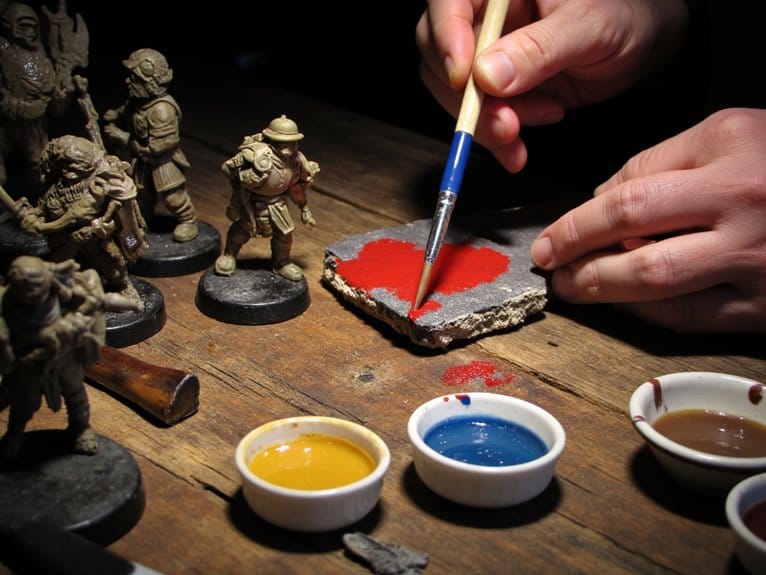We are supported by our audience. When you purchase through links on our site, we may earn an affiliate commission, at no extra cost for you. Learn more. Last update on 1st July 2025 / Images from Amazon Product Advertising API.
You’ll achieve superior precision with synthetic brushes for miniature painting because they maintain sharp points longer than natural alternatives and offer better control for fine detail work. Synthetic fibers resist paint absorption, preventing unwanted drips while working efficiently with fast-drying acrylics that dominate the hobby. They’re also more durable, lasting 12+ months compared to natural brushes’ 6-month lifespan, and cost considerably less at $2-8 versus $8-25 for natural options. Understanding their specific advantages will help you maximize your painting results.
Notable Insights
- Synthetic brushes maintain sharp points longer than natural hair, providing superior precision for detailed miniature work
- They perform optimally with acrylic paints by resisting absorption and maintaining stiffness throughout application cycles
- Synthetic brushes offer exceptional durability, lasting 12+ months with proper care compared to 6 months for natural alternatives
- Easy maintenance with simple soap and water cleaning makes synthetic brushes practical for frequent painting sessions
- Cost-effective option ranging $2-8 versus $8-25 for natural brushes, with fewer replacements needed over time
Superior Control for Fine Detail Work
Precision defines the difference between amateur and professional miniature painting results.
Synthetic advantages become immediately apparent when you’re working on intricate details requiring consistent brush performance. The uniform fiber structure eliminates unpredictable bristle variations that plague natural hair brushes. You’ll achieve detail precision through smoother, more controlled strokes since synthetic fibers maintain their shape without splitting or fraying.
The controlled paint absorption gives you superior command over paint quantity. Unlike natural brushes that absorb excess paint, synthetic fibers release paint efficiently, preventing unwanted drips on delicate features. This controlled flow becomes essential when painting eyes, armor details, or weapon highlights where precision matters most.
The stiffer bristles provide immediate tactile feedback, allowing micro-adjustments during application. You’ll notice enhanced responsiveness that translates directly into cleaner lines and sharper detail work across your miniature painting projects. Synthetic brushes show greater durability against solvents and cleaning agents, maintaining their precision performance through countless painting sessions. Synthetic bristles excel with fast-drying acrylics, providing optimal performance for miniature painters who prefer acrylic paint systems. The affordable cost makes them accessible for painters at any skill level without compromising performance quality.
Maintaining Sharp Points for Precision
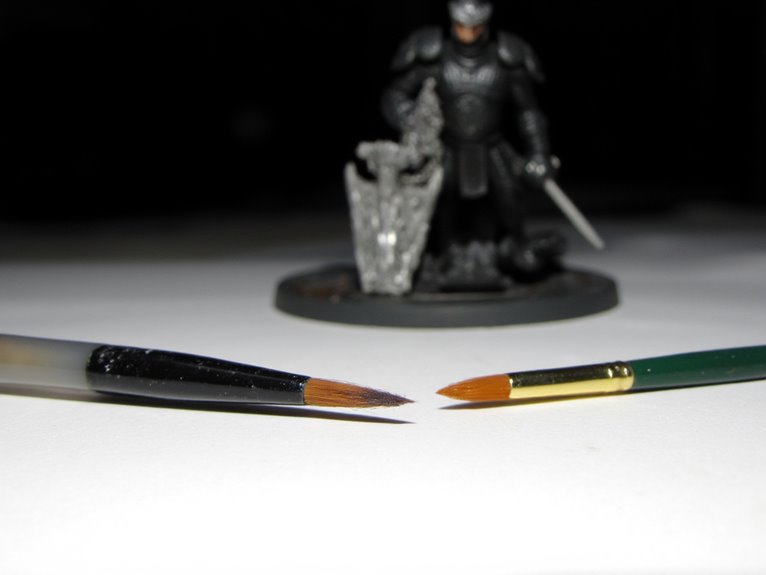
Sharp points separate mediocre detail work from exceptional miniature painting results.
Precision brush tips transform amateur miniature painting into professional-grade artistry through consistent detail control and unwavering accuracy.
Synthetic brushes maintain their precision tips considerably longer than natural alternatives, directly enhancing your brush accuracy for extended painting sessions. The engineered fibers spring back consistently after each stroke, preserving the fine point essential for detail precision.
Natural brushes splay and lose shape quickly, especially when exposed to metallic paints and frequent washing. Synthetic bristles resist this deterioration.
You’ll find synthetic materials like nylon withstand abrasive paint components that damage natural hair. The uniform fiber structure prevents uneven wear patterns that cause early tip blunting. This durability translates to sustained performance during intensive detailing work.
Cleaning doesn’t compromise synthetic brush points either. They tolerate vigorous washing while maintaining their sharp configuration, ensuring consistent precision throughout your miniature painting projects. Premium synthetic brushes with PBT nylon bristles provide excellent color retention and minimal shedding for enhanced durability. Metallic paints contain sharp flakes that can damage natural bristles, making synthetic brushes the superior choice for these challenging materials.
Synthetic brushes provide excellent coverage due to their efficient paint holding and releasing properties, allowing miniature painters to achieve consistent color application across detailed surfaces.
Optimal Performance With Acrylic Paints
When you’re working with acrylic paints on miniatures, synthetic brushes deliver superior performance through their engineered resistance to water-based formulations.
The synthetic brush advantages become evident as fibers resist paint absorption, maintaining consistent bristle stiffness throughout your painting session. This resistance prevents the softening that natural hair experiences with water-based acrylics.
The acrylic paint synergy with synthetic bristles creates ideal working conditions. Fast-drying acrylics require brushes that won’t absorb moisture and compromise paint flow.
Synthetic fibers maintain their structural integrity when exposed to acrylic mediums, preventing deformation during rapid application cycles. You’ll notice improved control as bristles retain their snap and responsiveness. High-quality acrylic paints are essential for both novices and experienced painters, offering excellent self-leveling properties that work optimally with synthetic brush technology.
The chemical compatibility between synthetic materials and acrylic formulations reduces paint buildup while ensuring consistent application. This engineered relationship maximizes precision during detail work while extending brush lifespan considerably. Additionally, synthetic bristles demonstrate exceptional durability compared to natural alternatives, maintaining their shape and performance through countless painting sessions.
For budget-conscious painters, synthetic brushes offer practical advantages that make them suitable for achieving tabletop standard results without significant investment.
Smooth Paint Release and Coverage
Beyond superior chemical compatibility, synthetic brushes excel at controlled paint dispensing that transforms your miniature painting workflow. The nylon and polyester fibers release paint steadily without excessive absorption. This creates smooth texture application across detailed surfaces. You’ll notice fewer brush marks and consistent coverage quality.
Paint viscosity works best with synthetic bristles. Thin glazes flow evenly while thicker paints maintain proper consistency. The controlled release reduces repeated dipping, accelerating your painting process. You can achieve precise layering without paint buildup on delicate miniature features. Quality water-based paints work particularly well with synthetic brushes, as their non-toxic formulas flow smoothly through the synthetic fibers without causing damage or degradation.
Synthetic fibers maintain their shape during extended sessions. Sharp tips deliver accurate paint placement exactly where you need it. The resilient bristles handle multiple paint types effectively, from standard acrylics to specialized washes, ensuring reliable performance across diverse miniature painting techniques. While synthetic brushes may have reduced paint retention compared to natural hair options, their consistent performance makes them valuable for controlled application work.
Enhanced Durability and Longevity
Durability stands as synthetic brushes’ most compelling advantage for miniature painters who demand consistent performance across countless painting sessions. Modern fiber technology creates bristles from nylon and polyester that resist wear far better than natural alternatives. You’ll find these brushes maintain their shape through repeated cleaning cycles and abrasive paint applications.
| Performance Factor | Natural Hair | Synthetic Fiber |
|---|---|---|
| Wear Resistance | Moderate | High |
| Shape Retention | 6 months | 12+ months |
| Medium Compatibility | Limited | Universal |
| Cleaning Tolerance | Delicate | Robust |
| Cost Replacement | Frequent | Minimal |
Synthetic versatility extends brush life up to 50% longer with proper care. The fibers withstand harsh cleaning agents and pigment abrasiveness that quickly damages natural hair. This durability translates to fewer replacements and consistent detail work. Professional miniature painting kits often include specialized brushes with synthetic fibers specifically designed for precision work across multiple paint mediums.
Simplified Cleaning and Maintenance
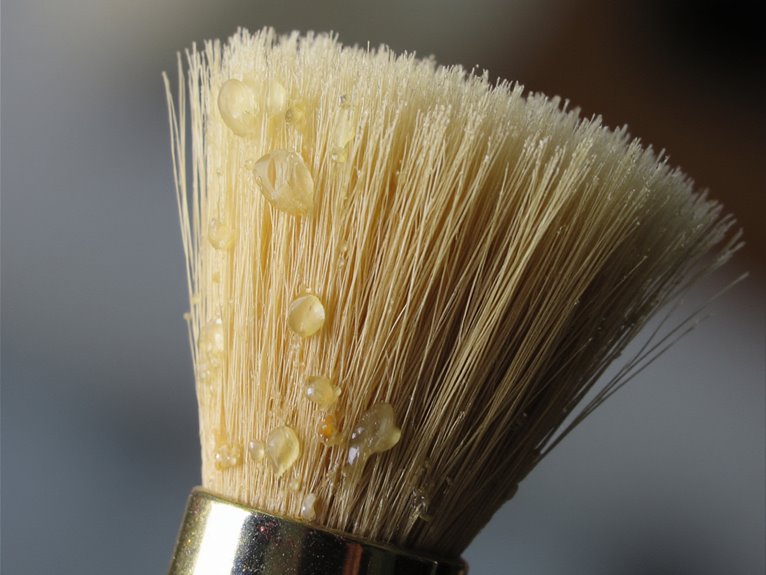
Since synthetic fibers resist absorbing paint and water compared to natural hair, you’ll spend less time maintaining these brushes and can clean them more aggressively without damage.
The non-porous nylon and polyester bristles prevent acrylic paint from penetrating deeply, allowing simple rinses with warm soapy water to remove residue completely. You can use household dish soap or specialized brush cleaners without fear of damaging the synthetic fibers.
Daily cleaning becomes straightforward—quick water rinses between colors suffice during painting sessions. The bristles maintain their shape after washing cycles, eliminating time-consuming reshaping routines.
Synthetic brushes tolerate vigorous cleaning methods and heat-assisted techniques with vinegar solutions. Studies show proper maintenance extends synthetic brush lifespan by 50% compared to neglected brushes, making them exceptionally cost-effective for frequent users.
Cost-Effective Investment
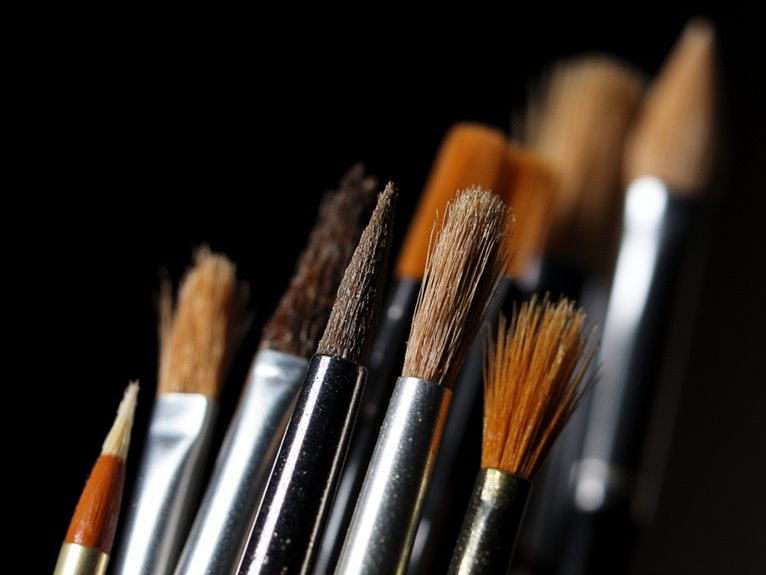
Most painters discover that synthetic brushes deliver exceptional value through their combination of low upfront costs and extended durability. You’ll achieve significant cost savings compared to natural hair alternatives, which often cost three to five times more initially. Synthetic bristles maintain their shape longer and resist fraying, extending usable lifespan by 40-60% over natural options.
| Expense Category | Synthetic Brushes | Natural Brushes |
|---|---|---|
| Initial Cost | $2-8 per brush | $8-25 per brush |
| Maintenance Products | None required | $15-30 annually |
| Replacement Frequency | Every 12-18 months | Every 6-10 months |
| Paint Absorption | Minimal waste | 20% more paint used |
Your financial efficiency improves through reduced maintenance costs. Synthetic brushes don’t require conditioning oils or special treatments, eliminating ongoing expenses that natural brushes demand for proper preservation.
Animal-Friendly Alternative
You’ll find that synthetic brushes offer significant ethical advantages over traditional animal hair alternatives when painting miniatures.
These brushes eliminate the need for harvesting hair from sables, squirrels, minks, and other animals, providing a completely cruelty-free painting solution.
Ethical Sourcing Benefits
Synthetic brushes represent a clear departure from traditional animal-derived bristles, offering miniature painters an ethical alternative that doesn’t compromise on performance.
These brushes eliminate animal exploitation entirely through nylon and polyester manufacturing processes. You’ll avoid supporting industries that farm or capture animals specifically for hair harvesting.
The environmental impact extends beyond individual welfare concerns. Synthetic production occurs in controlled facilities with standardized quality measures, reducing variable sourcing issues. You won’t encounter misleading labels like “Red Sable,” which typically contains weasel hair rather than actual sable.
This transparency allows informed purchasing decisions based on actual materials. Ethical considerations become particularly relevant as synthetic technology advances.
Modern synthetic fibers now match natural hair performance while maintaining consistent batch quality. You’re supporting cruelty-free market growth that encourages continued innovation in animal-free art supplies.
Versatility Across Multiple Techniques
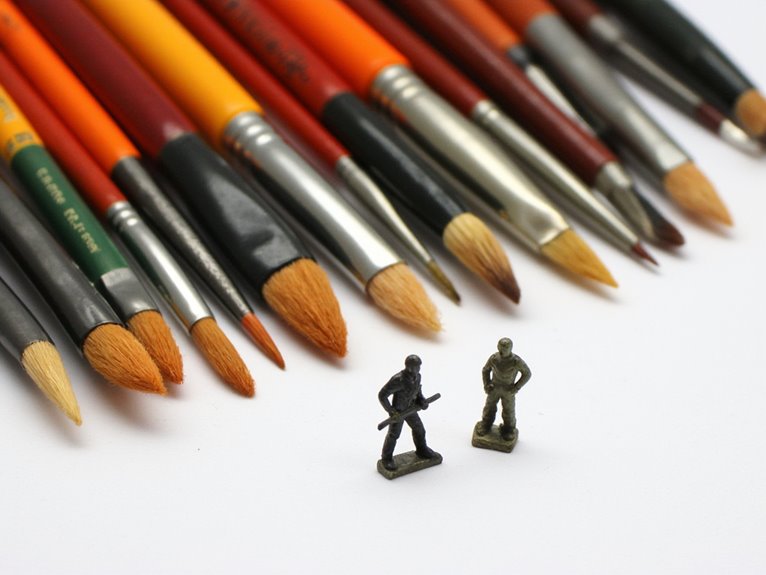
You’ll find synthetic brushes excel across diverse painting mediums, from water-based acrylics to alcohol-based inks and even specialized miniature paints like Vallejo Model Color or Citadel paints.
Their non-porous synthetic fibers won’t absorb different paint formulations, allowing you to switch between techniques like wet blending, dry brushing, and glazing without cross-contamination or bristle degradation.
This adaptability means you can master everything from broad basecoating to precise edge highlighting using the same brush set.
Multiple Medium Compatibility
Although miniature painters often work with different paint types throughout a single project, one brush can handle the shift seamlessly.
Synthetic brushes excel across acrylics, watercolors, and oils without requiring medium-specific tools. You’ll maintain consistent performance when switching between basecoats and detail work using different paint formulations.
The nylon and polyester fibers adapt to varying drying times and viscosities. Quick-drying acrylics won’t damage the bristles, while slower oils release smoothly without clogging.
You can perform color mixing directly on your palette or miniature using the same brush across mediums. Multiple brush shapes work effectively with each paint type, eliminating the need for dedicated brushes.
This versatility proves essential during complex projects requiring glazes, washes, and detail work with different mediums within single painting sessions.
| Painting Method | Natural Hair Response | Synthetic Performance |
|---|---|---|
| Heavy Dry Brushing | Bristles fray and split | Maintains stiff structure |
| Stippling | Tips deform quickly | Preserves sharp points |
| Thick Paint Application | Softens and loses shape | Retains firmness |
| Abrasive Textures | Breaks under pressure | Resists wear damage |
| Repeated Scrubbing | Splays permanently | Returns to original form |
Nylon and polyester fibers withstand constant pressure without breaking down. You’ll notice synthetic brushes maintain their snap-back even after hundreds of aggressive strokes. This resilience translates to consistent performance throughout demanding painting sessions.
Consistent Performance With Thinned Paints
When you’re working with thinned paints on miniatures, synthetic brushes deliver superior paint flow control through their engineered fiber structure that regulates paint distribution across the brush tip.
You’ll notice reduced water absorption compared to natural hair brushes, which prevents the bristles from becoming waterlogged and losing their precise shape during extended painting sessions.
This controlled absorption maintains brush responsiveness, allowing you to execute smooth glazes and controlled washes without the unpredictable paint release that can compromise detail work.
Superior Paint Flow Control
Most miniature painters struggle with unpredictable paint behavior when using thinned acrylics, but synthetic brushes deliver remarkably consistent flow control that eliminates these frustrations.
The plastic composition of synthetic bristles creates uniform contact with miniature surfaces, producing smooth strokes without blotching. Unlike natural brushes that absorb excess paint into their fibers, synthetic bristles maintain steady paint flow rates throughout each stroke. You’ll experience minimal paint “bursts” or unexpected releases that ruin detail work. The rigid structure prevents over-saturation while preserving sharp tip geometry.
- Controlled paint release prevents pooling on small surfaces and fine details
- Uniform bristle contact guarantees smooth gradient alterations during layering
- Reduced absorption keeps thinned paints at ideal consistency on brush tips
- Steady flow rates eliminate need for frequent corrections or reloading
- Sharp points maintain accuracy when working with extremely diluted paint mixtures
Reduced Water Absorption
Water absorption becomes a critical factor when you’re working with thinned acrylics on miniature surfaces.
Synthetic fibers absorb markedly less water than natural bristles, preventing swelling that compromises tip shape and springiness. This reduced absorption maintains consistent brush performance throughout your painting session.
Water retention effects directly impact paint delivery precision. Natural brushes can dilute your carefully thinned paints through excess absorption, weakening color intensity and opacity.
Synthetic brushes preserve your intended paint mixture ratios by minimizing water uptake.
The stable fiber structure enables predictable behavior with water-thinned mediums. You’ll achieve smoother layering and better flow control without inadvertent paint pooling.
Your brush maintains consistent wetness levels, supporting fine detail work and preventing fiber deformation. This reliability extends brush lifespan while delivering superior performance for repetitive base coating applications.
Understanding the Trade-offs
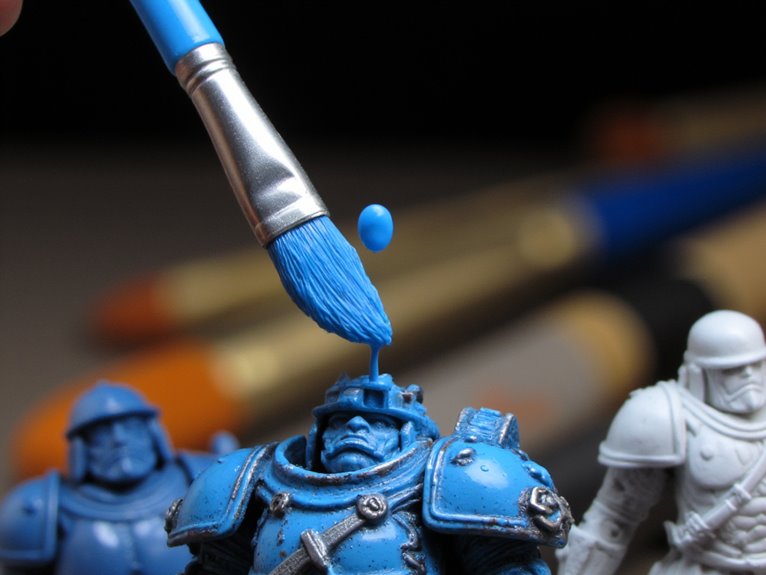
While synthetic brushes offer impressive accessibility and affordability, they come with performance compromises that directly impact your miniature painting results.
This trade offs overview reveals specific performance limitations you’ll encounter during detailed work.
Synthetic bristles absorb less paint than natural hair, requiring frequent reloading that slows your workflow.
Their inherent stiffness provides excellent line control but severely limits smooth blending capabilities.
You’ll struggle with subtle gradations and glazing techniques that natural brushes handle effortlessly.
The reduced paint holding capacity forces you to work faster before paint dries on the brush tip.
While synthetic brushes excel at sharp edges and precise details, they can’t match natural brushes for soft washes or naturalistic color shifts.
Understanding these limitations helps you choose the right tool for each specific technique.
On a final note
You’ll find synthetic brushes deliver the precision and reliability miniature painting demands. They maintain sharp points longer than natural alternatives while providing superior control with acrylic paints. Their reduced absorption means less paint waste and more consistent coverage. Though they can’t match natural brushes’ paint-holding capacity, their durability and wide availability make them the practical choice. You’re investing in tools that’ll consistently perform across extended painting sessions with minimal maintenance requirements.

